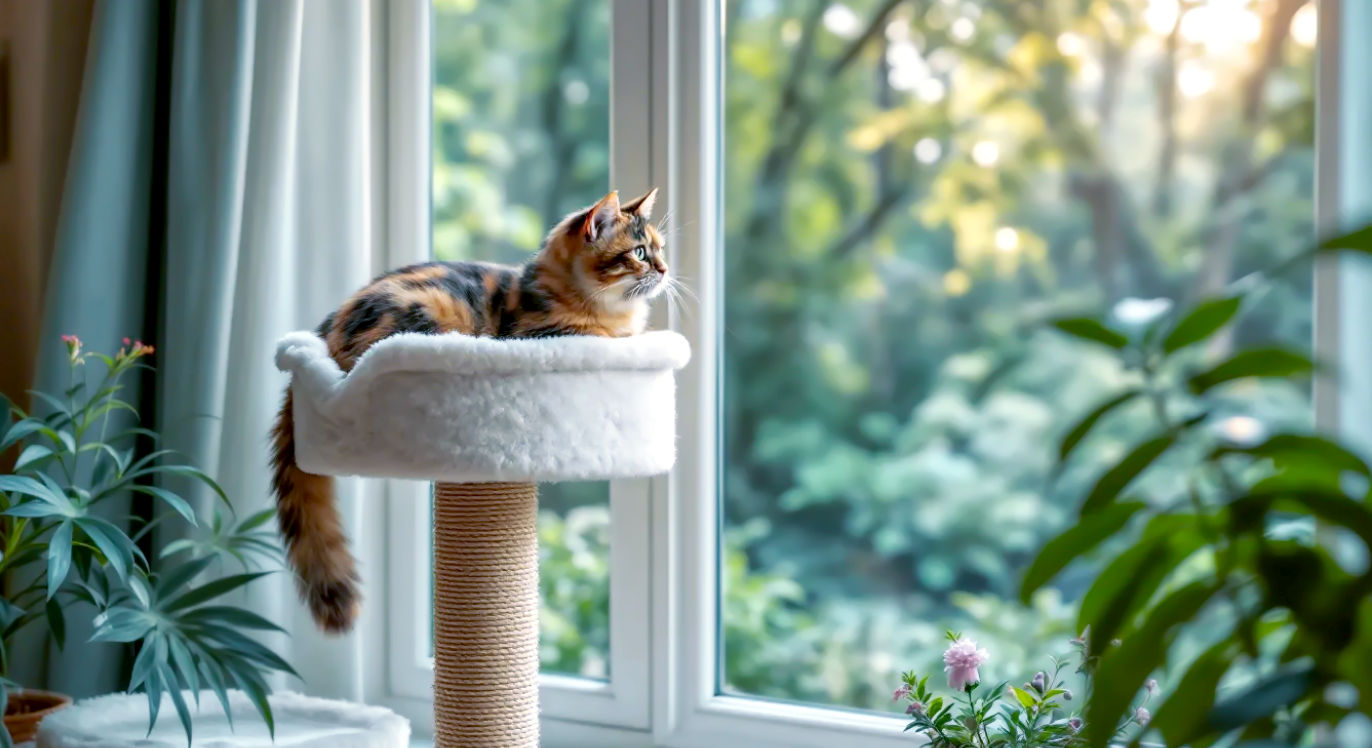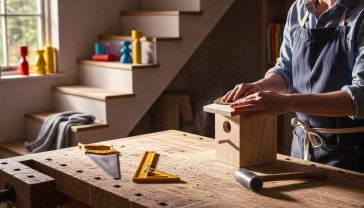The Cat Furniture Guide for Our Feline Friends: More Than Just a Scratching Post
The definitive guide for British cat lovers on choosing the perfect furniture. From space-saving wall shelves to cosy radiator beds, we cover it all.

This post may contain affiliate links. If you make a purchase through these links, we may earn a commission at no additional cost to you.
If you share your home with a cat, you’ll know they’re not just pets; they’re family. They’re furry little tyrants who rule the roost, and we wouldn’t have it any other way. But to keep our feline overlords happy, healthy, and off the new sofa, we need to give them a space they can truly call their own. That’s where cat furniture comes in. It’s not just about a tatty old scratching post tucked away in a corner. It’s about creating a rich, stimulating environment that caters to your cat’s natural instincts.
Think of your cat. What’s it doing right now? Chances are it’s either snoozing in a sunbeam, peering out the window like a neighbourhood watch captain, or plotting its next zoomie session around the living room. Cats are natural climbers, scratchers, hunters, and sleepers. In the wild, they’d be scaling trees, sharpening their claws on bark, and surveying their territory from a high vantage point. Our cosy British homes don’t always offer these opportunities, which can lead to boredom, stress, and some very shredded curtains.
This guide is your one-stop shop for understanding the wonderful world of cat furniture. We’ll explore why it’s so vital for your cat’s well-being, break down the different types available, and help you choose the perfect pieces for your home and your furry companion. Whether you live in a spacious house in the Cotswolds or a chic flat in Manchester, there’s a solution for every cat and every budget. So, let’s dive in and create a home that your cat will love you for.
Why Do Cats Even Need Special Furniture?
It’s a fair question. After all, cats seem perfectly happy sleeping on our beds, our clean laundry, and even our heads. But purpose-built cat furniture does more than just keep them comfy; it’s essential for their physical and mental health.
Tapping into Their Inner Tiger
At their core, domestic cats are still wired like their wild ancestors. Their daily life revolves around a few key activities: hunting, climbing, scratching, and hiding.
- The Urge to Get High: Cats are vertical creatures. In the wild, a high perch means safety from predators and a great spot to watch for prey. This instinct doesn’t just disappear because they live indoors. Cat trees and wall shelves give them a safe space to climb and observe their kingdom (your living room) from above. This sense of security can do wonders for a nervous cat’s confidence.
- Scratching Isn’t Naughty, It’s Necessary: When your cat sinks its claws into your new armchair, it’s not being destructive just for the fun of it. Scratching is a vital, instinctive behaviour. It helps them shed the outer layers of their claws, keeping them sharp and healthy. It’s also a way to stretch their back and shoulder muscles—think of it as cat yoga. And importantly, it’s how they mark their territory. Cats have scent glands in their paws, so every time they scratch, they’re leaving a little “I was here” message for any other cats in the area. Providing a sturdy scratching post gives them an approved outlet for this behaviour.
- A Place to Hide and Feel Safe: Even the most confident cat needs a place to retreat when things get a bit overwhelming—whether it’s the hoover coming out, guests arriving, or just a noisy Tuesday. Enclosed beds, condos, and tunnels provide a dark, cosy sanctuary where they can feel safe and secure.
Keeping Them Healthy and Happy
The right furniture doesn’t just satisfy instincts; it actively boosts your cat’s health.
- The Indoor Activity Centre: For indoor cats, especially, a lack of stimulation can lead to boredom and, ultimately, obesity. A multi-level cat tree encourages jumping, climbing, and playing, providing a much-needed workout. It’s like a built-in gym that helps keep them lean and agile.
- Stress Busting: A bored cat is often a stressed cat. This stress can manifest in unwanted behaviours like over-grooming, spraying, or aggression. By providing an enriching environment with plenty of places to play, scratch, and rest, you’re giving them a healthy way to burn off energy and de-stress.
- Saving Your Sofa (and Your Sanity): Let’s be honest, this is a big one. By providing dedicated and attractive scratching surfaces, you drastically reduce the chances of your furniture, carpets, and wallpaper falling victim to those sharp claws. It’s a simple trade-off: give them something they can scratch, and they’re far less likely to scratch something they shouldn’t.
In short, cat furniture isn’t a luxury; it’s a cornerstone of responsible cat ownership. It turns your house into a home for your feline friend, respecting their natural needs and ensuring they lead a happier, healthier life.
The Grand Tour of Cat Furniture: From Simple Scratchers to Feline Palaces
Cat furniture has come a long way from the beige carpet-covered posts of the past. Today, the options are vast, with something to suit every cat’s personality and every home’s decor. Let’s break down the main categories.
Scratching Posts and Scratchers: The Essentials
If you only buy one piece of cat furniture, make it a good scratcher. They are non-negotiable for any cat owner.
- The Classic Scratching Post: This is the bread and butter. The best ones are tall, sturdy, and wrapped in a satisfying material like sisal rope. A tall post (at least 90cm or 3 feet) allows your cat to get a full, glorious stretch while they scratch. Stability is key; if it wobbles, they won’t use it. Look for one with a heavy, wide base.
- Scratching Pads and Ramps: These are brilliant for cats who prefer scratching on a horizontal or angled surface. They often come as flat pads or inclined ramps made of corrugated cardboard. Cardboard scratchers are typically very affordable and cats adore them. The only downside is they can be messy as they get shredded, but many come in a frame to contain the confetti. They are a great, low-cost option to place around the house.
- Corner Scratchers: These are clever little things that fit around the corner of a wall or sofa, protecting the areas cats naturally love to target. They’re a fantastic way to redirect scratching away from your furniture.
Cat Trees and Condos: The All-in-One Adventure Zone
Cat trees (or cat condos) are multi-functional pieces that combine scratching posts, perches, and hideaways. They are the ultimate piece of feline real estate.
- What Makes a Great Cat Tree?
- Height: Taller is often better. A tree that reaches near the ceiling will be a huge hit, giving your cat that coveted high-up vantage point.
- Sturdiness: This is crucial. A wobbly cat tree is an unused cat tree. Look for a wide, heavy base and solid construction. It needs to withstand a full-pelt kitty launch without tipping over.
- Variety is a Spice of Life: The best trees offer a mix of features. Look for multiple levels, high-up perches or beds for surveying, enclosed ‘condos’ for napping, and scratching posts on different levels. Dangling toys are a bonus.
- Choosing the Right Size:
- For Small Flats: You don’t need a floor-to-ceiling monster. A compact, medium-sized tree with a few levels and a good scratching surface can be perfectly adequate. Look for designs with a smaller footprint.
- For Multiple Cats: If you have more than one cat, you need a tree with multiple perches and beds at the highest level. This prevents squabbles over the top spot. Cats have a social hierarchy, and providing several prime locations can help keep the peace.
Cat Shelves and Wall-Mounted Furniture: The Space-Saving Solution
For those of us in smaller British homes, floor space is precious. Wall-mounted cat furniture is a genius solution that gives your cat a vertical playground without cluttering up your living room.
- Creating a “Cat Superhighway”: You can buy individual shelves, steps, and hammocks to create a custom climbing route along your walls. This allows your cat to travel around a room without ever touching the floor—a dream come true for most felines!
- What to Look For: Ensure the shelves are securely fixed to the wall (find the studs!) and can comfortably hold your cat’s weight. They should have a non-slip surface; carpet or sisal-covered shelves are ideal. Arrange them like a staircase, with manageable distances between each step, to encourage safe and easy climbing.
Cat Beds and Hideaways: The Perfect Place for a Catnap
Cats sleep for up to 16 hours a day, so a comfortable bed is a must. While many will happily kip on your pillow, giving them their own dedicated spots is always a good idea.
- Enclosed and Cave Beds: These are incredibly popular because they provide that sense of security cats crave. The enclosed design makes them feel safe and hidden, perfect for a deep, uninterrupted snooze. They come in all sorts of fun designs, from igloos to sharks.
- Radiator Beds: An absolute favourite in the UK! These are beds with a metal frame that hooks securely over a radiator. Cats adore the warmth, and it gets them off the floor into a cosy, elevated spot. They’re a brilliant, space-saving option for the colder months.
- Window Perches: These are beds or platforms that attach to a windowsill or directly to the window with suction cups. They give your cat a front-row seat to the best show in town: the world outside. It’s ‘Cat TV’ at its finest, providing hours of stimulation as they watch birds, people, and leaves blowing by.
Material Matters: What’s the Best Stuff for Cat Furniture?
The materials used in cat furniture are just as important as the design. They need to be durable, safe, and, most importantly, appealing to your cat.
For Scratching: The Textures Cats Crave
- Sisal Rope: This is the gold standard for scratching posts. It’s a tough, natural fibre that provides a highly satisfying shredding experience for cats. It’s incredibly durable and stands up well to even the most enthusiastic scratchers.
- Sisal Fabric: A woven fabric version of sisal. It’s also very durable and offers a slightly different texture that many cats enjoy. It’s a great choice for wrapping around larger surfaces on a cat tree.
- Corrugated Cardboard: Cheap, cheerful, and utterly irresistible to cats. They love the way it shreds under their claws. It’s not as long-lasting as sisal, but its low cost means it’s easy to replace.
- Wood and Bark: For a more natural look, some scratchers use plain wood or posts with the bark left on. This closely mimics what cats would scratch in nature and can be a big hit.
- Carpet: While common, carpet isn’t always the best choice for scratching surfaces. It can snag a cat’s claws, and it teaches them that scratching carpet is okay—which can be confusing if you have carpets on your floor! If a cat tree has carpeted sections for lounging, that’s fine, but for the main scratching areas, sisal is superior.
For Lounging: Softness and Comfort
- Faux Fur / Fleece / Plush Fabric: These are the most common materials for the beds and perches on cat trees. They are soft, warm, and cosy—everything a cat wants for a nap. Look for options with removable, machine-washable covers for easy cleaning.
- Natural Wood and Wicker: For a more stylish, minimalist look, furniture made from wood or wicker can blend beautifully with modern decor. Just make sure any finishes or stains are non-toxic, and pair them with soft cushions for comfort.
Safety First: What to Avoid
- Toxic Materials: Ensure any glues, paints, or finishes used are non-toxic and pet-safe.
- Loose Strings and Small Parts: Avoid furniture with small, dangling parts that could be chewed off and swallowed. Any attached toys should be securely fastened. Long loops of string can also be a strangulation hazard.
- Unstable Construction: Always check for stability. A piece of furniture that could topple over is a serious danger to your cat.
Location, Location, Location: Where to Put Your Cat Furniture
You can buy the most extravagant, top-of-the-range cat palace, but if you put it in the wrong place, your cat will ignore it. Placement is everything.
Think Like a Cat
To get it right, you need to see your home from your cat’s perspective. Where are the most important spots in their world?
- The Heart of the Home: Cats want to be where the action is. Placing a cat tree in the corner of the living room, where the family spends most of their time, makes it a prime piece of real estate. This allows your cat to be part of the social group but from a safe, elevated distance. A cat tree hidden away in a spare room will likely gather dust.
- Room with a View: Position a tall cat tree or a window perch in front of a window. This provides endless entertainment and stimulation. They can watch the world go by, chatter at birds, and bask in the sun.
- Scratching Post Hotspots: Place scratching posts in prominent locations, especially near the entrances to rooms or next to furniture you want to protect. Cats often scratch when they wake up, so putting a post near their favourite sleeping spot is a great idea. If your cat has already started scratching a particular piece of furniture, place a new, appealing scratching post right next to it to redirect the behaviour. Don’t hide the post away; scratching is also a form of communication, and they want their scratch marks to be seen!
Creating a Harmonious Multi-Cat Household
If you have more than one cat, the placement of furniture can be a powerful tool for keeping the peace.
- Provide Multiple Resources: To avoid conflict, you need to provide multiple key resources. This means more than one scratching post, several high-up resting spots, and multiple entry/exit points to rooms.
- Spread Them Out: Don’t clump all the furniture together. Spreading cat trees, beds, and scratchers throughout the house allows cats to have their own space and avoid competing for the same spot. A tall cat tree with several perches in the main living area can act as a “peacekeeping tower,” allowing multiple cats to share the same vertical space without being in each other’s direct line of sight.
The DIY Option: Building Your Own Cat Furniture
For the crafty and budget-conscious, creating your own cat furniture can be a rewarding project. It allows you to customise the design to perfectly fit your space and your cat’s preferences.
Simple DIY Projects
- Cardboard Box Castle: The simplest project of all! Cats love cardboard boxes. You can cut holes in them, stack them, and stick them together to create a fun, temporary fort. It costs next to nothing and provides hours of fun.
- Basic Scratching Post: This is a great beginner’s project. All you need is a solid wooden post (a fence post from a DIY shop works well), a heavy, stable base (a square of plywood is perfect), and a roll of sisal rope. Simply secure the post to the base and then tightly wrap the sisal rope around the post, securing it with non-toxic glue or staples at the top and bottom.
- DIY Cat Shelves: You can turn simple wooden shelves from shops like B&Q or IKEA into cat shelves. Just cover them with a piece of carpet remnant or a sisal mat to provide grip. Make sure you mount them securely to the wall.
Tips for Safe DIY
- Use Cat-Safe Materials: Always use untreated wood, non-toxic glues and paints, and safe fabrics.
- Sand Everything Smooth: Make sure there are no splinters or sharp edges that could harm your cat.
- Build it to Last: Stability is paramount. Make sure your creations are sturdy and won’t fall over when your cat leaps onto them. Double-check all fixings and screws.
Keeping It Clean: Maintenance Tips
To keep your cat furniture safe, appealing, and hygienic, a little bit of regular maintenance goes a long way.
- Regular Hoovering: Cat fur gets everywhere. Use a vacuum with a pet hair attachment to regularly clean fabric and carpeted surfaces.
- Washing Removable Covers: If your cat beds or tree perches have removable covers, pop them in the washing machine every few weeks to keep them fresh.
- Spot Cleaning: For any little accidents, use a pet-safe stain and odour remover. Avoid harsh chemicals like bleach, as they can be toxic to cats and the strong smell might put them off using the furniture.
- Checking for Wear and Tear: Regularly inspect the furniture for any signs of damage. Check that scratching posts are still stable, that sisal rope isn’t unravelling in a dangerous way, and that any attached toys are still secure. Repair or replace anything that looks worn out to keep it safe for your cat.
The Future of Cat Furniture: Trends to Watch
The world of cat furniture is always evolving, with designers creating ever more innovative and stylish options that cater to both cats and their humans.
- Stylish and Discreet Designs: The days of hiding monstrous, beige-carpeted towers are over. There is a growing trend for cat furniture that seamlessly blends into modern home decor. Think sleek wooden cat trees that look like sculptures, or stylish side tables that double as a cosy cat bed. Brands are focusing on minimalist designs and natural materials that appeal to human aesthetic sensibilities.
- Modular and Customisable Systems: One size doesn’t fit all. Modular systems that allow you to add, remove, and rearrange components are becoming more popular. This means you can build a custom setup that perfectly fits your space and can be expanded or changed over time as your cat’s needs change.
- Sustainability: Eco-conscious pet owners are driving demand for furniture made from sustainable, recycled, or natural materials. We’re seeing more products made from reclaimed wood, recycled cardboard, and organic fabrics.
Your Cat Furniture Action Plan: A Summary
Choosing the right furniture can feel a bit overwhelming, but it doesn’t have to be. Here’s a simple plan to get you started on creating the perfect feline-friendly home.
- Observe Your Cat: Before you buy anything, spend a few days watching your cat. Are they a climber who loves high places? A bush-dweller who prefers to hide under things? Do they scratch vertically on door frames or horizontally on the carpet? Understanding their personal preferences is the key to choosing furniture they’ll actually use.
- Start with the Essentials: Everyone needs a good, tall, sturdy, sisal-covered scratching post. This is your number one priority. Place it in a prominent social area.
- Invest in Vertical Space: A cat tree or wall shelves are the next step. This will satisfy their instinct to climb and survey their territory. Choose a size and style that fits your home and offers a variety of features. Remember to place it in a social room, preferably with a window view.
- Provide Cosy Retreats: Make sure they have at least one safe, cosy spot to sleep. A radiator bed for winter or an enclosed cave bed can provide the perfect sanctuary.
- Place it Wisely: Remember the golden rule: location, location, location. Put the furniture where your cat wants to be, not where it’s out of the way.
- Encourage and Praise: When you first introduce a new piece of furniture, encourage your cat to explore it. You can use toys, catnip, or treats to make it an exciting new place. Lavish them with praise and affection when you see them using it.
By investing a little time and thought into choosing the right cat furniture, you’re doing more than just spoiling your pet. You’re enriching their environment, supporting their natural behaviours, and strengthening the bond you share. You’re turning your shared house into a true home for your feline friend, and a happy, stimulated cat makes for a very happy human.
Further Reading & Resources
For those looking to explore further, here are some of the most respected UK-based organisations and resources for feline well-being:
- Cats Protection: The UK’s largest feline welfare charity, offering a wealth of expert advice on cat care, behaviour, and health. https://www.cats.org.uk/
- International Cat Care: A global charity providing high-quality, evidence-based information to improve the lives of all cats. https://icatcare.org/
- The Royal Society for the Prevention of Cruelty to Animals (RSPCA): The leading animal welfare charity in the UK, with comprehensive guides on pet care. https://www.rspca.org.uk/adviceandwelfare/pets/cats
- The Blue Cross: A UK charity dedicated to helping sick, injured, and homeless pets, offering expert advice on pet ownership. https://www.bluecross.org.uk/advice/cat






